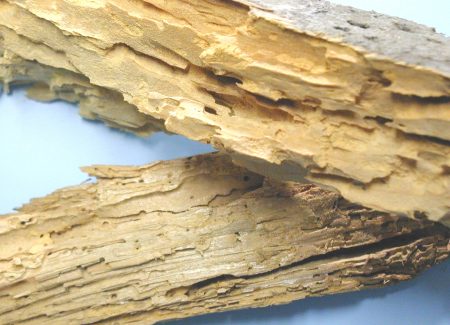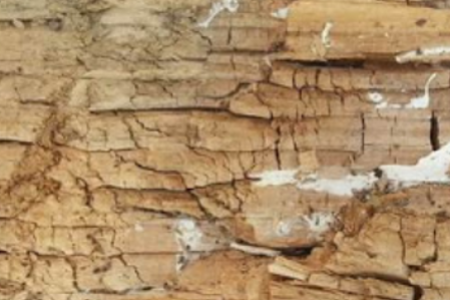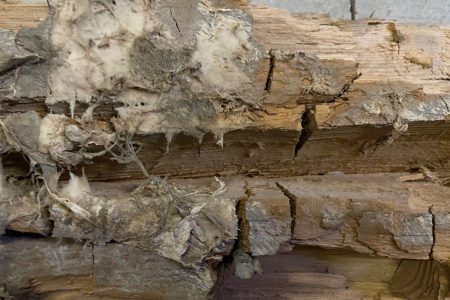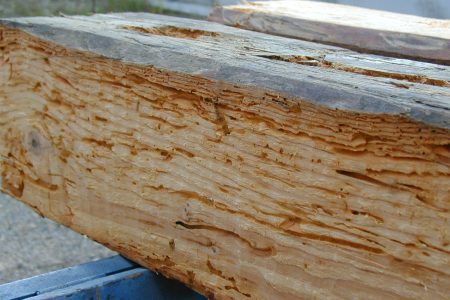How to identify wood-decay fungi
Wood-decay fungi or xylophagous fungi are a group of several species of fungi that digest moist wood, breaking down the fibers with their hyphae.
When conditions are right, wood-decay fungi can be found growing in or on wood materials as this is an ideal food source. Unlike traditional plants, wood-decay fungi rely on living or dead wood to feed as they are unable to photosynthesize. While there is a wide variety of wood-decay fungi, they are most often categorized by the type of decay they cause. The three most common types are brown rot, white rot, and soft rot.

Where does wood decay come from?
To thrive, wood-decay fungi require specific conditions to help them live and grow. Regardless of where they are found they need air, water, and food. Some of the specific requirements include warm temperatures (between 50°-100°F) and an ideal food source with enough moisture. However, saturated wood can cause poor oxygen exchange with the outside air but should contain at least 20% moisture. Without at least 20% moisture, the fungi are unable to degrade the wood and advance in or on the wood.
Whether it be in the wild or the home, one thing is for sure: wood-decay fungi are looking for moist wood. When inspecting the home for these fungi, the most common places to check are in the basement or crawl spaces. However, given the wooden structures of many homes, areas like window or door frames, roofs, and the attic are susceptible as well. It is important to note that wood-decay fungi and subterranean termites are often associated with one another. This is due to the level of moisture necessary for the fungi to thrive which also attracts termites. If wood-decay fungi are found, termites could be nearby so it is important to be able to recognize the differences in damage.
Learn about the differences between wood rot and termite damage.
Different types of wood-decay fungi
When brown rot occurs, it is very destructive to the structural elements of the home as it attacks the holocellulose (cellulose + hemicellulose) as well as the cell walls. Being able to attack the cell wall of the wood is one of the reasons for the rapid loss of strength. A characteristic of wood attacked by brown rot is the cracked brick-like decay, as well as a crumbly or brittle nature.
Slightly different in behavior and nature, white rot specifically attacks the lignin in the wood. Some white rot may also attack the cellulose while others may leave it behind. This attack on the lignin causes some wood to take on a spongy, stringy texture and appearance. It most often manifests in a white or yellow color and may sometimes appear to be wet. Much like brown rot, white rot weakens the wood, the decay allowing the softened fibers to be easily separated and the wood to be peeled apart.


Different from the others, soft rot attacks wood in conditions where brown or white rot cannot. Soft rot attacks where there are higher moisture levels and in temperatures too hot or too cold for other decay. It does its damage working from the surface inwards which causes cavities to form. Soft rot is less destructive than white rot and tends to cause decay similar in appearance to brown rot.
Damage and potential dangers
Regardless of the type of wood-decay fungi, it is important to treat the problem as early as possible. Wood-decay fungi do just as their name states, decay the wood structures of the home slowly over time. Although each type of rot feeds on a different wood component (cellulose, hemicellulose, lignin) each can be just as destructive if left untreated. Feeding on the wood structures of a home, over time these fungi will weaken the structure. Left for long enough and this could lead to collapse, a dangerous and costly risk for homeowners.
Much like King Midas who could turn anything he touched into gold, wood-decay fungi can harm anything they touch. While the issue starts in a localized area, the rot could eventually spread to boards nearby, drywall, and even insulation. This spreading can also attract other wood-destroying organisms like termites who also feed on the cellulose of decayed wood. The damp wood is softer and therefore easier to chew and tunnel through, thus becoming an ideal termite food source. Similar to termites, the problem generally starts out going unnoticed, evolving and advancing within, sometimes until it is too late.
And while wood decay may only cause direct harm to the home, its presence can cause other health hazards. The warm, damp conditions wood decay needs to survive are the same conditions dangerous for humans. Excess moisture in the air can also cause surface fungi to grow such as mold and mildew. In these conditions, mold can spread quickly, releasing spores into the air that cause humans to cough, sneeze, and other respiratory issues. Mold is also known to cause additional reactions such as headaches, itchy eyes, and skin rashes.

Preventing wood-decay fungi
Since wood-decay fungi attack damp wood in warm temperatures it is important to treat the source before it becomes an issue. Inside the home, air out traditionally humid areas if possible, if not, installing a dehumidifier is helpful. These areas include basements, attics, and crawl spaces but can extend to other areas like bathrooms or laundry rooms. Complete routine checks to ensure there are no leaks that could cause excess moisture. This could be anywhere in the home including around toilets, sinks, and washing machines. Immediately repair leaks and properly dry and inspect for any potential wood damage.
Outside of the home, don’t forget about porches or decks made of wood that come in contact with the ground. When building, set structural wood on supporting elements that rest on metal plates planted in concrete raised above the ground level. Treat the rest of the wood with water repellent to minimize possible water damage from the elements. Regularly inspect porches and decks for damage control and to prevent possible wood rot.
If you notice signs or suspect wood damage in your home, we recommend contacting a professional to assess the potential damage.
To buy MABI injectors to treat for wood-decay fungi, contact one of our distributors.